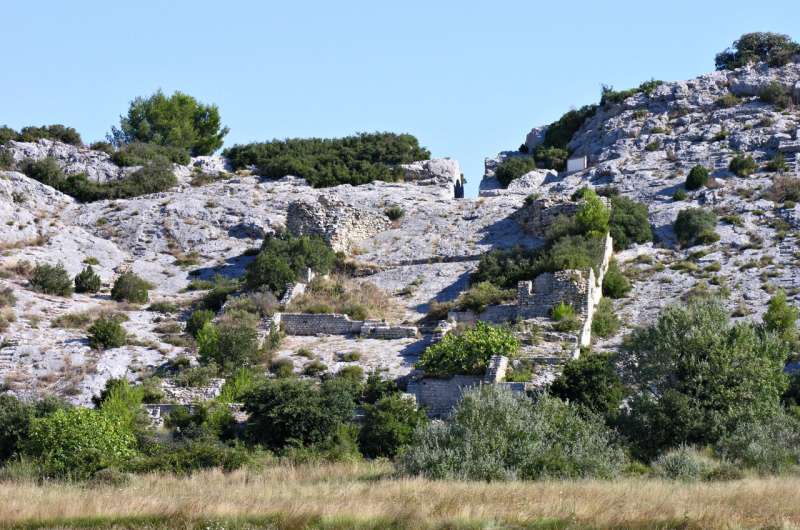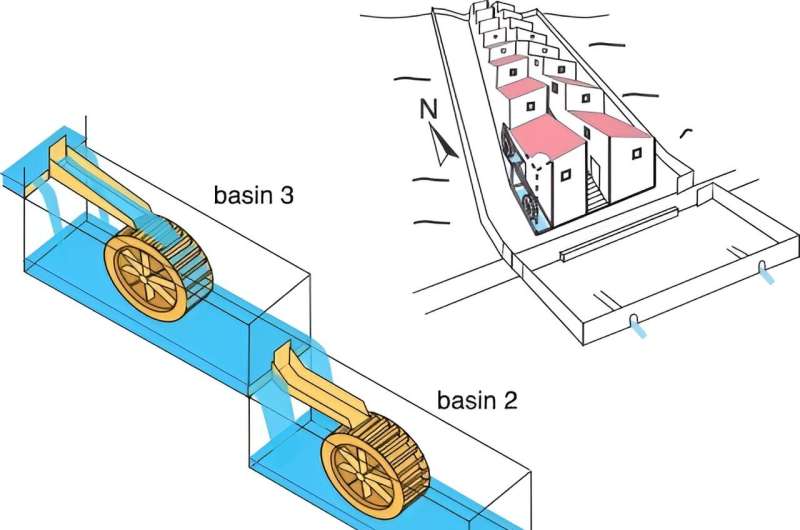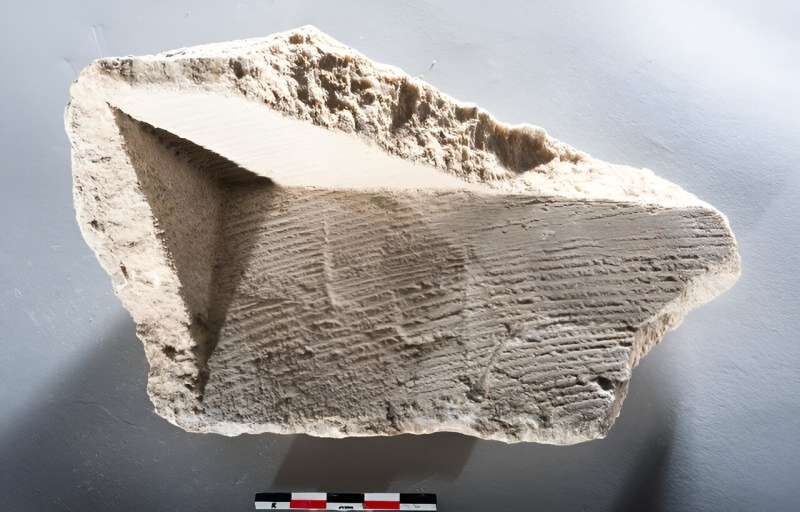
View of the ruins of the Barbegal mill complex in 2018. Credit: Robert Fabre
Archaeologists face a major challenge when they want to gather information about buildings or installations of which only ruins remain. This was particularly the case for the remains of the Roman watermills of Barbegal, in the south of France, dating from the 2nd century CE.
This unique industrial complex consisted of 16 water wheels arranged in parallel rows, eight to the east and eight to the west, which functioned like a waterfall. Initially, these now insignificant ruins did not allow us to deduce much about the site, except that the wheels were powered by an aqueduct that brought water from the surrounding hills.
A coin issued during the reign of Emperor Trajan, discovered in a basin above the mill complex, as well as the structural features of the site, indicate that the mill was in use for about 100 years. However, the type of mill wheels, their function and how they were used have remained a mystery until now.
Carbonate fragments provide remarkable information
Professor Cees W. Passchier and Dr. Gül Sürmelihindi from the Johannes Gutenberg University Mainz (JGU), together with colleagues from France and Austria, have now elucidated the history of the mill complex using calcium carbonate deposits that are now stored in the Archaeological Museum of Arles.
These deposits had formed towards the end of the approximately 100-year operational life of the Barbegal watermills on the sides and base of the wooden supply system that carried water to the wheels.
“We show that it is possible to reconstruct a large part of the history of a water mill from such carbonate deposits,” says Passchier, head of the JGU team. The researchers first had to put together some of the 140 stored pieces like a puzzle, and then analyzed the layers using various techniques, including mass spectrometry.

Sketch of the Barbegal mill complex with three water basins with mill wheels and water channels. The lower basins probably had elbow-shaped channels. Credit: Cees Passchier
The water wheels and wooden gutters were replaced
The researchers have now published their results in Geoarchaeology“We were able to demonstrate, for example, that wooden waterwheels and flumes had to be replaced after three to eight years. In at least one case, an old waterwheel was replaced with a larger one,” said Passchier.
The researchers drew this conclusion from the unusual shape of the carbonate deposits that formed in the water channel. While the lower and earlier layers indicate that the water level must have been relatively low originally, the upper and later layers of carbonate indicate a higher water level.
The researchers rejected the hypothesis that the water flow in the canal was initially lower and then increased. They established that in a gently sloping canal with a low water level, the water flow provided would not have been sufficient to turn a mill wheel.
The inclination of the water channel therefore had to be changed from a steeper angle with a low water level to a gentler slope carrying the water to a proportionally higher level.
“The entire structure of this water mill had to be modified,” explains Passchier. “If you only raise the water channel, the water tends to splash around, which causes the wheel to lose the power it needs to operate the mill efficiently. Therefore, when you raise the water channel, you also need a larger water wheel.”
In fact, a section of carbonate deposit formed on the waterwheel supports this conclusion because it does not contain all the carbonate layers but only those from the last years of operation.

Fragment of carbonate from the Barbegal mills, formed on the wood of the mill machinery, with wood prints and traces of woodworking. Credit: Philippe Leveau
Isotope analysis results provide evidence of plant lifespan
Using isotopic analysis of the carbonate layers, the researchers were even able to determine the operating periods before which the plant parts had to be renewed. Carbonate contains oxygen, and the relative ratios of oxygen isotopes differ depending on the water temperature. Based on the isotopic composition of the carbonate layers, the researchers were able to deduce the water temperatures and thus identify the seasons in which the layers were deposited.
They concluded that the carbonate from the samples at the Arles Archaeological Museum had been deposited in waterways over a period of seven to eight years.
“The most recent and therefore uppermost carbonate layer contains mollusc shells and fragments of wood, which shows that the mill must have been abandoned at that time and was in the process of disintegrating. The water continued to flow for some time, which allowed the formation of carbonate deposits, but maintenance of the water channels ceased,” Passchier said.
The researchers were able to answer another question. Until now, it was not known whether the mills were operated together by a single operator or whether the 16 water wheels were used independently of each other.
Judging by the layers of the three studied canals, which are clearly different from each other, the mills were operating separately, at least towards the end of their existence. Moreover, the western side of the complex was abandoned earlier than the eastern side.
Eventually, long pieces of carbonate from the water channels were later used as partitions in a water basin for other industrial purposes after the mills had already been abandoned.
More information:
Cees W. Passchier et al, Operation and Decline of the Barbegal Mill Complex, the Largest Industrial Complex in Antiquity, Geoarchaeology (2024). DOI: 10.1002/gea.22016
Provided by Johannes Gutenberg University Mainz
Quote:Carbonate layers provide insight into ancient Roman world (2024, July 1) retrieved July 1, 2024 from https://phys.org/news/2024-07-layers-carbonate-insight-world-ancient.html
This document is subject to copyright. Apart from any fair dealing for the purpose of private study or research, no part may be reproduced without written permission. The content is provided for informational purposes only.